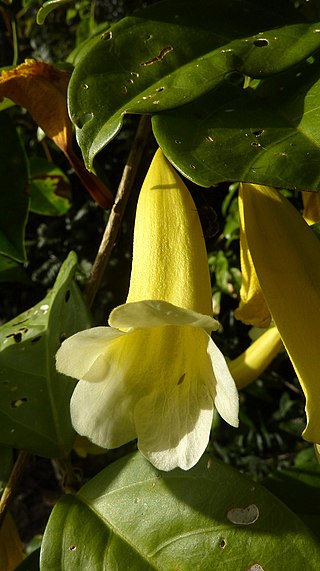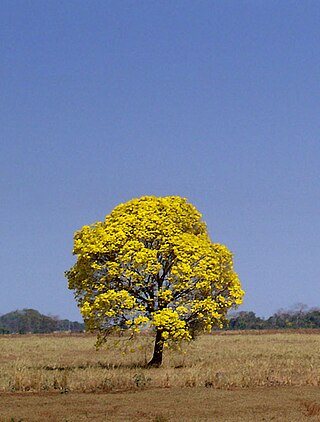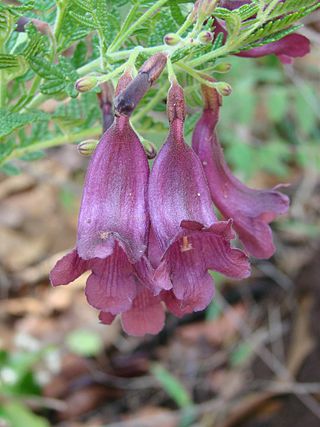
Tabebuia is a genus of flowering plants in the family Bignoniaceae. Tabebuia consists almost entirely of trees, but a few are often large shrubs. A few species produce timber, but the genus is mostly known for those that are cultivated as flowering trees.

Bignoniaceae is a family of flowering plants in the order Lamiales commonly known as the bignonias or trumpet vines. It is not known to which of the other families in the order it is most closely related.

Jacaranda mimosifolia is a sub-tropical tree native to south-central South America that has been widely planted elsewhere because of its attractive and long-lasting violet-colored flowers. It is also known as the jacaranda, blue jacaranda, black poui, Nupur or fern tree. Older sources call it J. acutifolia, but it is nowadays more usually classified as J. mimosifolia. In scientific usage, the name "jacaranda" refers to the genus Jacaranda, which has many other members, but in horticultural and everyday usage, it nearly always means the blue jacaranda.

Plumeria, also known as frangipani, is a genus of flowering plants in the subfamily Rauvolfioideae, of the family Apocynaceae. Most species are deciduous shrubs or small trees. The species are native to the Neotropical realm, but are often grown as cosmopolitan ornamentals in tropical regions, especially in Hawaii, as well as hot desert climates in the Arabian Peninsula with proper irrigation.

Bignonia is a genus of flowering plants in the family Bignoniaceae. Its genus and family were named after Jean-Paul Bignon by his protégé Joseph Pitton de Tournefort in 1694, and the genus was established as part of modern botanical nomenclature in 1753 by Carl Linnaeus. Species have been recorded from the southern USA, Central to most of South America.

Stereospermum is a genus of trees in the paleotropical clade of the family Bignoniaceae. A species of Stereospermum is used in herbal medicine in Ayurveda as well as it is an integral part of the culture and tradition of the cold desert biosphere reserve.

Anemopaegma is a genus of flowering plants in the family Bignoniaceae. Species of Anemopaegma along with many other unrelated plants go by the name of catuaba.

Mansoa is a genus of tropical, flowering vines in the family Bignoniaceae.

Handroanthus is a genus of flowering plants in the family Bignoniaceae. It consists of 30 species of trees, known in Latin America by the common names poui, pau d'arco, or ipê. The latter sometimes appears as epay or simply ipe (unaccented) in English. The large timber species are sometimes called lapacho or guayacan, but these names are more properly applied to the species Handroanthus lapacho and Handroanthus guayacan, respectively.

Mitracarpus is a plant genus in the coffee family Rubiaceae. Girdlepod is a common name for some species in this genus.

Amphilophium is a genus of flowering plants in the family Bignoniaceae, native to South America. Amphilophium crucigerum has escaped from cultivation elsewhere, and has become an invasive weed in Australia.

Jacaranda caerulea is a flowering tree belonging to the genus Jacaranda. It is native to the West Indies, in Cuba, Hispaniola and the Bahamas.

Jacaranda ulei is a flowering tree native to the Cerrado region of Brazil. It was first described by Édouard Bureau and Karl Moritz Schumann in 1897.
Pleonotoma is a genus of tropical, flowering lianas located in the family Bignoniaceae.

Dolichandra is a genus of flowering plants in the family Bignoniaceae, native to Latin America and the Caribbean. They are climbing lianas with trifid and uncate tendrils. The best-known species is Dolichandra unguis-cati.
Xylophragma is a genus of flowering plants in the family Bignoniaceae, native to dry forests of Mexico, Central America, Trinidad and northern South America. They are lianas or scandent shrubs.

Heterophragma is a genus of two species of tree, constituting part of the plant family Bignoniaceae. The species are found in Southeast Asia and India.
Phyllarthron is a genus of flowering plants belonging to the family Bignoniaceae.
Martinella is a genus of flowering plants belonging to the family Bignoniaceae. It is a genus of Neotropical lianas within the tribe Bignonieae.





















